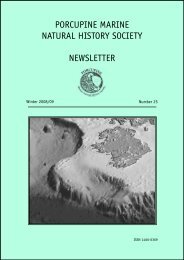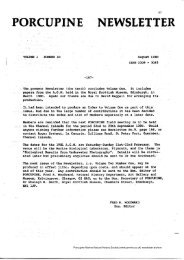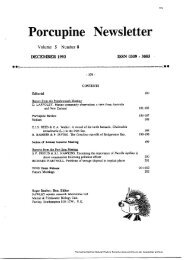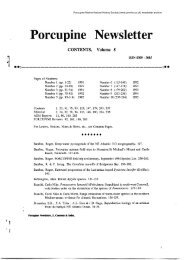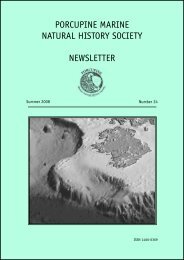Porcupine Newsletter - Porcupine Marine Natural History Society
Porcupine Newsletter - Porcupine Marine Natural History Society
Porcupine Newsletter - Porcupine Marine Natural History Society
You also want an ePaper? Increase the reach of your titles
YUMPU automatically turns print PDFs into web optimized ePapers that Google loves.
and locality record for this species.<br />
At this depth some specimens of the giant<br />
scavenging amphipod Eurythenes gryllus were<br />
also collected along with three other species<br />
found in smaller numbers.<br />
Deeper traps: 1000-1600m (3 traps:<br />
1069m, 1396m, 1611m)<br />
At these depths Eurythenes gryllus was<br />
the dominant species, certainly in terms of<br />
biomass if not numbers. Only one species of<br />
Anonyx was found at these depths (A. nugax),<br />
and two species of Tmetonyx. At this depth<br />
species of the genus Paracallisoma are also<br />
found. This genus is only found in these deeper<br />
waters and is very problematic taxonomically.<br />
Following on from this study a complete family<br />
revision of the Scopelocheiridae (to which<br />
Paracallisoma belongs) has been undertaken<br />
and is nearing completion.<br />
Table 1 : Baited trap deployment details<br />
Trap<br />
number<br />
Date Station<br />
Number<br />
Summary<br />
Scavenging amphipods from the Faroe-<br />
Shetland Channel were collected by the means<br />
of baited traps as part of the DTI’s Strategic<br />
Environmental Assessments. In total 11 traps<br />
form part of this qualitative study of the<br />
scavenging species in the area. The traps<br />
all collected a large number of specimens<br />
and these are now in the process of being<br />
formally identified and enumerated to assess<br />
the species diversity of the different study<br />
depths and locations. At the current state of<br />
identification the traps can be split into three<br />
groups – shallow, mid-depth, and deeper traps<br />
for which the corresponding dominant species<br />
are Tmetonyx cicada, Anonyx & Tmetonyx spp,<br />
and Eurythenes gryllus respectively. Work on<br />
these collections continues and involves a<br />
taxonomic revision of the Scopelocheiridae,<br />
species of which were recorded from the deeper<br />
traps.<br />
Depth Approx<br />
depth<br />
Latitude<br />
(degrees<br />
minutes)<br />
Longitude<br />
(degrees<br />
minutes)<br />
1 21/07/96 53759#1 498 500 60 59.4918 2 29.9137<br />
2 22/07/96 53768#1 781 800 61 7.7262 2 42.2231<br />
3 23/07/96 53778#1 289 300 60 53.8092 2 22.0973<br />
4 25/07/96 53799#1 508 500 61 26.6526 1 31.5477<br />
5 26/07/96 53809#1 294 300 61 32.3922 1 9.0164<br />
6 27/07/96 53817#1 775 800 61 24.8094 1 57.177<br />
7 28/07/96 53826#1 1069 1100 61 18.036 2 29.8276<br />
8 16/08/96 53979#1 1396 1400 61 28.719 2 47.6602<br />
9 13/08/02 57060#1 1611 1600 62 39.16 1 13.97<br />
10 15/08/02 57077#1 888 900 62 15.645 0 19.266<br />
11 19/08/02 57101#1 198 200 61 34.593 0 29.464 E<br />
PMNHS <strong>Newsletter</strong> No.19 Feb 2006 19<br />
<strong>Porcupine</strong> <strong>Marine</strong> <strong>Natural</strong> <strong>History</strong> <strong>Society</strong> (www.pmnhs.co.uk) newsletter archive<br />
19



